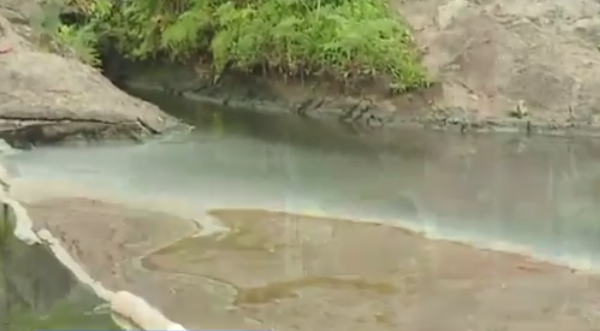Roads back open after cooking oil spill on Country Club Plaza
BY Rob Collins,
Updated at 06:04AM, April 28, 2017
KANSAS CITY, Mo. -- Roads are back open Friday morning and clean-up crews have cleared the scene of a cooking oil spill that occurred Thursday afternoon on the Country Club Plaza.
The spill happened near Roanoke and Ward Parkway when a truck owned by Brooks Grease Service overturned on the bridge. A tank of used cooking oil spilled all over the road and into Brush Creek.
The Kansas City Fire Department brought in the hazardous materials unit to clean the mess. They used "soak pads" and sand to soak up all of the oil from the road.
The oil in Brush Creek, a bigger issue, and more difficult to clean. Firefighters placed buoys in the water to catch it and grease trucks also came along to skim the grease off of the surface.
KCMO Deputy Fire Chief James Garret said, other than the rancid smell, there is no danger to the public.
There is no word on just how much oil was spilled. FOX 4 is told the driver of the grease truck was taken to the hospital.
===========
KANSAS CITY, Mo -- The smell on the Plaza Thursday afternoon was enough to make even the most devoted fried food fan give it up.
A truck owned by Brooks Grease Service was hauling used cooking oil and overturned on the bridge at Roanoke Parkway and Ward Parkway, spilling its load on to the streets and into Brush Creek.
Typically restaurants store used cooking oil in a holding tank and sell it to be recycled and reused. Sara Schwalm, whose family owns a restaurant, knows the process and the smell well.
"When it is sitting in that tank it actually becomes pretty rancid, and it is pretty gross," said Schwalm. "You are also getting the smell of the cooked fries and chicken and onion rings and anything else that you are cooking."
Deputy Fire Chief James Garrett says besides the smell, there is no danger to the public.
"Really no danger at all except for getting the grease on your car and spreading it around everywhere," he explained.
The Kansas City, Missouri Fire Department, including the Hazardous Materials Unit, used soak pads and sand to soak up the oil from the roadways, but getting the oil from the water in Brush Creek was more difficult.
Some of the oil from the overturned truck made its way downstream before firefighters were able to place buoys in the water to catch it. Grease trucks skimmed the oil off of the surface of the water.
The driver of the truck was taken to the hospital with non-life threatening injuries.


The environmental disaster that changed California — and started the movement against offshore oil drilling
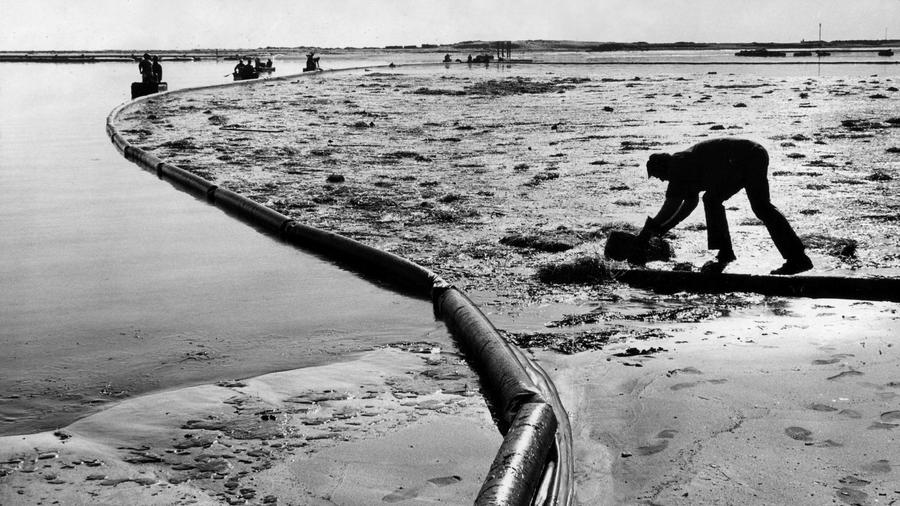
Men in boats and onshore gather straw used to soak up oil in Santa Barbara Harbor in 1969. (Los Angeles Times)
By Shelby Grad
The prospect of allowing new oil drilling off the coast of California is placing President Trump on yet another collision course with the state.
California has been a leader in restricting offshore oil drilling since the 1969 Santa Barbara oil spill. It was the worst oil spill in the nation’s history – until 20 years later, when the Exxon Valdez dumped 11 million gallons of crude off the coast of Alaska.
The spill was a seminal moment in both California and American environmental history.
Here’s a retrospective of that moment from the archives of The Times: In the winter of 1969, 3 million gallons of oil began leaking from an offshore drilling site off the Santa Barbara coast. It would eventually be contained, but the incident helped spark landmark environmental legislation to protect the nation's waters and air. (Los Angeles Times )
In the winter of 1969, 3 million gallons of oil began leaking from an offshore drilling site off the Santa Barbara coast. It would eventually be contained, but the incident helped spark landmark environmental legislation to protect the nation's waters and air. (Los Angeles Times )
SHATTERING THE SEA FLOOR
How the spill happened
Union Oil Co.'s Platform A, boring nearly a mile beneath the waves, punctured a high-pressure pocket of petroleum. Oil exploded from the breach so violently that it shattered the sea floor and gushed uncontrollably into the blue Pacific, congealing into a chocolate mousse mat a foot thick. Winds carried part of the oil southwest to San Miguel Island, and the rest was tugged by currents toward Santa Barbara.
"The thing I remember most about it was the noise of the waves breaking on the beach ended," said Robert Sollen, author of "An Ocean of Oil," a book about offshore drilling. "The water was heavy and lubricated with oil. There was total silence."
Captured live on TV, the images of dying animals and frantic cleanup crews changed the consciousness of the nation. The spill "was the most important event that led to the environmental revolution of the 1970s," U.S. Interior Secretary Bruce Babbitt told The Times in 1999. "That was the event that galvanized public awareness of the environment and support for a decade of profound change."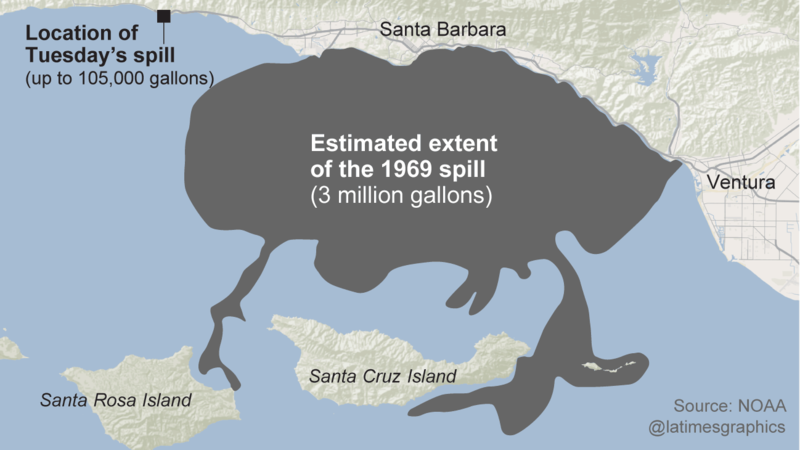 This is an estimate of the 1969 oil spill compared to a much smaller oil spill that occurred in 2015.
This is an estimate of the 1969 oil spill compared to a much smaller oil spill that occurred in 2015.
DEVASTATING THE COAST
Images stunned the world
Oil spewed into the water at the rate of 1,000 gallons per hour for a month before workers could begin to slow it down.
Before it was over, an oil slick coated the coastal waters and stretched 35 miles from Rincon Point, on the Santa Barbara-Ventura County line, to Goleta. The oil was so thick and heavy at some beaches that breaking waves were silent.
Night after night, viewers were sickened by images of oil-drenched birds that couldn't fly, sea otters that couldn't swim, and tides that brought in the corpses of dead seals and dolphins.
The spill even prompted a presidential visit to Santa Barbara, which suffered widespread damage to its sea grass and underwater flora. When newly sworn President Nixon saw the tarnished coastline, he remarked that the "incident has frankly touched the conscience of the American people."
The cleanup was painstaking and slow. Oil was soaked up by using straw and cat litter.
It took years for Santa Barbara's ecosystem to recover. An oil-drenched duck undergoes a cleaning. The spill also claimed many seals and dolphins. (Los Angeles Times)
An oil-drenched duck undergoes a cleaning. The spill also claimed many seals and dolphins. (Los Angeles Times)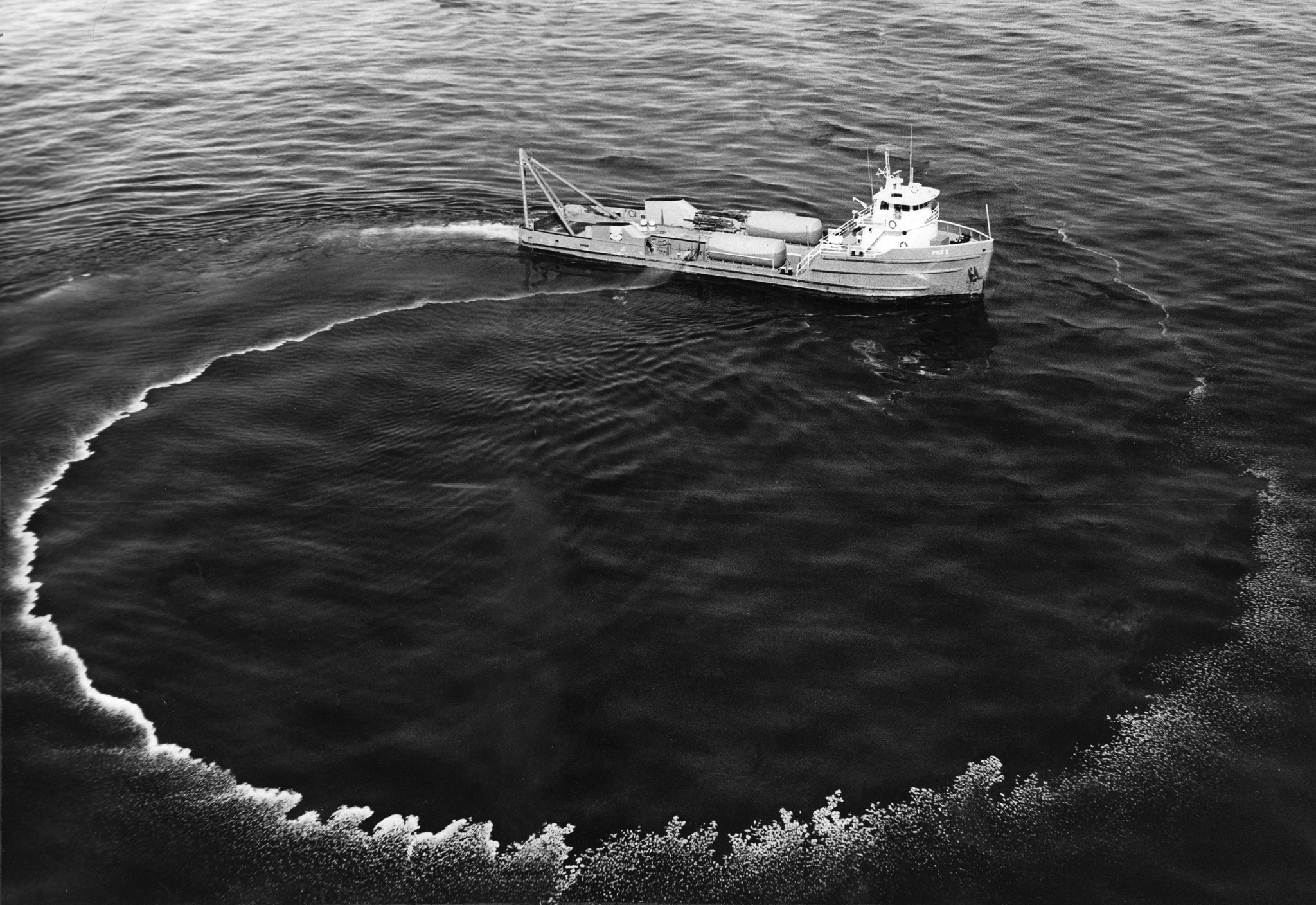 A 140–foot workboat sprays chemicals to disperse the slick that coated the coastal waters and eventually stretched 35 miles from Rincon Point, on the Santa Barbara–Ventura County line, to Goleta. (Los Angeles Times)
A 140–foot workboat sprays chemicals to disperse the slick that coated the coastal waters and eventually stretched 35 miles from Rincon Point, on the Santa Barbara–Ventura County line, to Goleta. (Los Angeles Times)
HOW THE OIL SPILL CHANGED THE COAST
Beginning of a movement
After the 1969 spill, the California State Lands Commission placed a moratorium on all new offshore drilling in state waters, even on existing leases. A federal moratorium has effectively banned new offshore drilling in the federal waters off California for decades. Today, there are 23 offshore oil and gas leases in state waters, according to the commission.
New federal policies established after the disaster required offshore oil platform operators to pay unlimited amounts toward oil spill cleanup costs, along with penalties of up to $35 million.
In the aftermath of the spill, Nixon signed the National Environmental Policy Act in 1969, which requires environmental impact reports, and the California Environmental Quality Act was adopted the next year, says Peter Alagona, an associate professor of environmental studies at UC Santa Barbara.
The nation’s first Earth Day, spearheaded by burgeoning grassroots environmental groups, was celebrated in 1970.
Laws regulating air and water pollution soon followed, as did legislation protecting sensitive coastal areas and endangered species.
A semi-truck caught fire on the southbound 5 Freeway near Colorado in Griffith Park on Tuesday, April 25, 2017.
Saturday, April 29, 2017 10:28AM
GRIFFITH PARK, LOS ANGELES (KABC) -- Officials on Saturday identified a big rig driver who was killed days earlier in a fiery multi-vehicle crash on the 5 Freeway near Griffith Park.
Thang Le, 41, died at the scene of the eight-vehicle collision that left 10 others injured just before 11 a.m. Tuesday, according to the Los Angeles County coroner's office.
Le, a resident of Gilbert, Arizona, was driving a 2004 Freightliner tractor-trailer at the time of the crash, which ignited a dramatic fire and prompted an hours-long closure of the interstate in both directions.
PHOTOS: Crews respond to crash on 5 Freeway

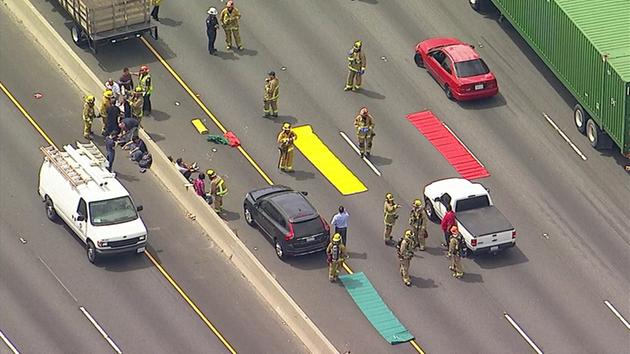

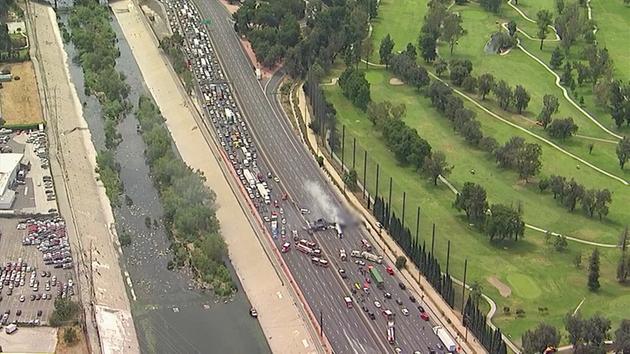

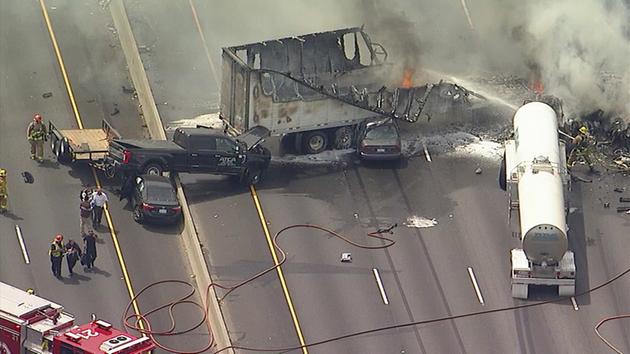
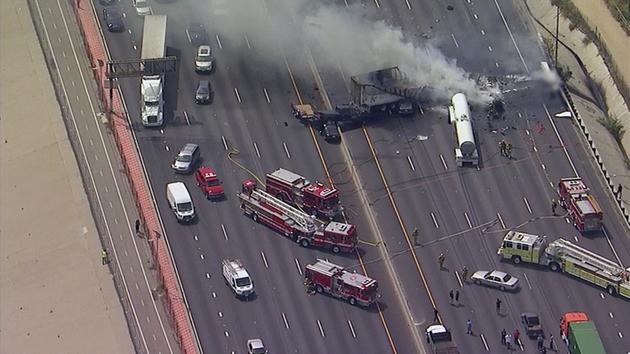
Crews respond to a multi-vehicle crash on the southbound 5 Freeway in Griffith Park on Tuesday, April 25, 2017.
According to a California Highway Patrol investigation, Le crashed into other vehicles and crossed over from the northbound side into the southbound lanes after he lost control of the semitruck for unknown reasons.
Los Angeles Fire Department firefighters responded to the scene and extinguished the massive flames by 11:30 a.m.







FRANKFORD, PHILADELPHIA, PA (WPVI) -- Philadelphia firefighters battled a four alarm fire inside a warehouse in the city's Frankford section.
Crews were called out around 4:15 a.m. Saturday to the 4200 block of Tackawanna Street where they found thick black smoke pouring from the building.
The fire forced evacuations for people living near the area.
Jack Suloff, a resident said, "The whole back alley was smoke. My kitchen filled up with smoke."
Another resident Alex Ramos said, "Flames were pretty high, like 20 feet high. They knocked on my door told me to get out of my house. I left,"
Soon flames burst through the roof. Firefighters worked to stop them from spreading from the warehouse, which spans the length of a city block. They called a second alarm.
Ramos added, "It must have started in the front and ended up in back- smoke - I thought other houses burn down that's how big it was."
For hours crews blasted water at the stubborn flames. Residents were briefly allowed to return home, but then had to evacuate again, for fear the back wall of the warehouse would collapse.
John Malinowski, a resident said, "The second time they told me to evacuate because building might be unsafe."
Firefighters were ordered to lead off with their heaviest water lines to help combat the raging fire.
At 4:27 a.m. firefighters called in a third alarm as the fire continued to spread throughout the building.
By about 8:45 a.m. crews got the blaze under control.
Firefighters evacuated residents from several homes from Auth Street, which runs adjacent to the warehouse.
The Red Cross arrived to assist the residents.
No injuries were reported and no word yet on what sparked the fire.
WATCH HILL, Fire Island (WABC) -- Seven people were rescued after their boat ran aground off Fire Island early Saturday morning.
Around 12:30 a.m., a group riding in a 21-foot Mako boat were heading from Brookhaven toward Sayville when the boat ran aground and struck a sand dune 50 yards from the Watch Hill Marina on Fire Island.
A family member of one of the passengers called 911.
Upon arrival, police administered first aid to one passenger who had a leg injury, airlifting her to Stony Brook University Hospital.
The other six people refused medical attention and were taken to Sandspit Marina in Patchogue.
The Suffolk County Police Department is reminding boaters to carry a Marine VHF radio as well as a cell phone to call 911.

PORT MORRIS, New York (WABC) -- A 3-year-old girl was killed in a two-vehicle wreck on Bruckner Boulevard Saturday morning.
A private garbage truck and a 2010 Chevy Malibu sedan crashed around 10 a.m. in the Port Morris section of the Bronx.
Both were traveling north when the Chevy swerved in front of the truck to avoid a pothole, according to the New York City Police Department.
Police said the truck rear-ended the sedan pushing it into a metal pillar supporting the Bruckner Expressway in the 300 block of Bruckner Boulevard.
A 52-year-old woman was driving the sedan, and a 52-year-old man was in the front passenger seat. A 27-year-old woman was in the rear seat.
Police said the child was properly fastened into the rear seat of the vehicle.
All four victims were taken to Lincoln Hospital where the toddler was pronounced dead. The adults are all stable.
The identifications of the victims are pending notification of family.
The truck driver remained on the scene.
The carting truck is owned by Avid Waste Systems, of Hunts Point in the Bronx.
Only one lane was passable at the scene.





Barrel company facing fine for exposing workers to hazardous chemicals, unsafe practices
Raquel Rutledge , Milwaukee Journal Sentinel Published 7:01 p.m. CT April 21, 2017 | Updated 9:37 a.m. CT April 22, 2017
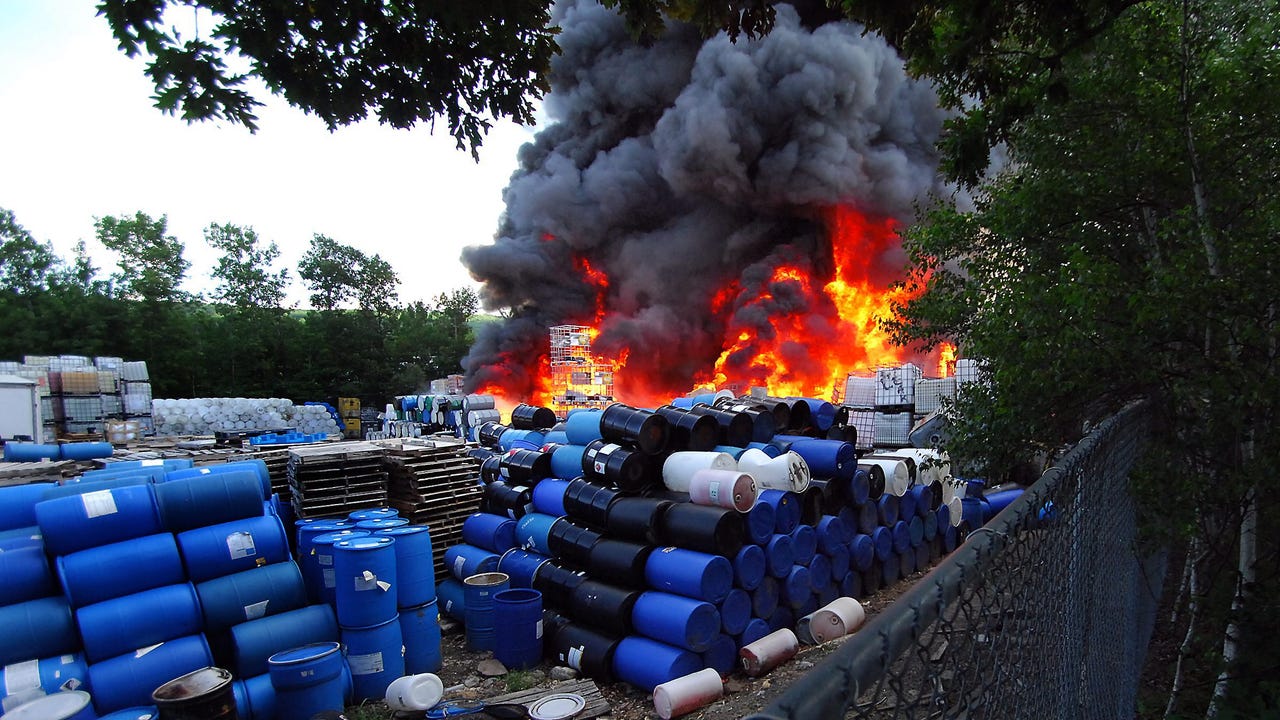
The Journal Sentinel findings are based on 16 hours of audio recordings of managers and workers inside the plants; hundreds of pages of documents, including safety audits from private consultants, injury reports, federal and state regulatory records,

(Photo: Will Kramer, former safety consultant to Greif Inc.)
An industrial drum refurbisher on Milwaukee’s north side faces $108,000 in federal fines stemming from serious safety violations that harm workers — and pose risks to the neighborhood.
The U.S. Occupational Safety and Health Administration has cited the Mid-America Steel Drum facility for 15 serious violations for exposing workers to chemical and heat-related burns, toxic gases, dangerous noise levels, the risk of falls and other hazards.
The “mixing of reactive materials/chemicals, as well as the mixing/addition of chemical unknowns, exposed employees to reactive chemical hazards," according to a citation and notification of penalty issued last week by OSHA.
The company, on Cornell St. near W. Hampton Ave. and N. 24th St., recycles and reconditions industrial totes and is among a group of similar facilities operated by a joint venture called Container Life Cycle Management — or “Click’m.” CLCM facilities employ about 270 people, with additional operations in St. Francis and Oak Creek as well as Indianapolis, Memphis, Tenn., and Arkadelphia, Ark.
CLCM is majority owned by industrial packaging giant Greif Inc., headquartered in Delaware, Ohio.
Officials from Greif said Friday they are “cooperating closely” with OSHA regulators.
“We are aware of OSHA’s findings and while we do not agree with the results of the inquiry, we’re committed to addressing issues in a timely manner,” a spokesman for Greif said in a written statement to the Milwaukee Journal Sentinel.
A Journal Sentinel investigation into Greif’s CLCM facilities published in February detailed how unsafe practices at the plants resulted in worker injuries and risks to the environment. Workers told the Journal Sentinel the drums that arrive at the plant for refurbishing and recycling are not always empty — violating regulations — and instead contain chemicals, including hazardous ones, sloshing in the bottom. Workers pour the various chemical residues into a container without knowing what they’re mixing and how the chemicals might react.
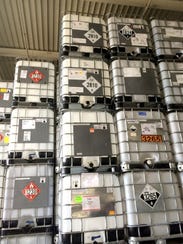
Workers say totes sometimes arrive at the plant with hazardous chemicals left sloshing in the bottom. (Photo: Will Kramer, former safety consultant to Greif Inc.)
The practice results in drums exploding and releasing toxic gases and vapors in the air. Workers have suffered severe chemical burns and respiratory illness, according to interviews and internal company records. In a 1984 case, before Greif/CLCM were involved with the business, a drum at a sister plant owned by Mid-America exploded in the face of a 23-year-old worker and killed him.
The Journal Sentinel's findings were based on 16 hours of audio recordings and hundreds of pages of injury reports and safety audits supplied by a whistle-blower; as well as federal, state and local regulatory records; photographs; medical examiner reports; police and fire records; U.S. Securities and Exchange reports; lawsuits; and interviews with eight recent workers from three plants, regulators, trade groups and chemical safety experts.
The OSHA citation substantiates the Journal Sentinel’s findings.
It notes, in part: “the employer receives, stores, and processes chemical containers (totes) that contain chemicals such as, but not limited to: hydrogen peroxide, isopropanol, sodium hydroxide, sodium hypochlorite, acetone, sulfuric acid, hydrochloric acid, and paints."
In addition, workers at the north side Milwaukee plant were exposed to fire dangers from acetone, which wasn’t properly handled, the OSHA citation states. Workers were not adequately informed about the risks of each of the hundreds of chemicals they were handling, the agency's inspectors found.
Workers were allowed to go back into the plant without “procedures in place to ensure that the work environment was safe following the release of unknown gases and vapors from unwanted chemical reactions," inspectors noted.
Will Kramer, a former risk assessment consultant who blew the whistle on Greif, said OSHA’s penalties illustrate a regulatory failure. The $108,000 fine amounts to “pocket change,” he said. Greif reported net sales of $3.3 billion in 2016.
Kramer said OSHA investigators didn’t contact him or seek evidence that the company was aware of its dangerous practices and deliberately ignored them. OSHA officials could not be reached for comment.
“In my role as a safety consultant to the company, we documented the same issues OSHA cited them for, and provided a detailed report with photos to the company's management with recommendations of how to fix the problems,” Kramer wrote in a letter Friday to U.S. Sen. Tammy Baldwin, who has called for multiple federal investigations into the problems with the Greif/CLCM plants.
Such evidence would have allowed the agency to classify the violations as “willful,” which carry much stiffer fines. Kramer said that might do more to “incentivize” the company to improve its practices.
OSHA conducted several inspections of the plant beginning in October 2016, after receiving a complaint from an employee. The inspections continued through April 6. The company has until May 30 to finish resolving all of the issues.
"This confirms that despite (Greif officials) saying they fixed all the problems, they’re still doing the same things," Kramer said.
Read the investigation
To read the Journal Sentinel's "Burned" investigation, into problems at drum reconditioning plants, go to jsonline.com/burned.
April 28th, 2017
United Steel Workers Local 676, Verso Corporation, reports the death of one of its members at the Beryl woodyard on April 8 was the result of a fall into a wood chip reclaimer.
Matthew Shumaker, 45, Westernport, a 20-year employee of the paper mill, had recently transferred from the converting plant to the woodyard, according to a report at www.usw.org/news.
Shumaker was on his last shift of a two-week training period and was running a dozer on the chip pile, the union said. "He dismounted from the dozer and walked parts of the chip pile for reasons unknown," the website stated.
Shumaker was standing near the chip reclaimer when a portion of the wood chip bed unexpectedly collapsed underneath him. He was working alone at the time, the statement said.
Mineral County Sheriff Jeremy Taylor told the Times-News this week that his investigation into the matter is completed. Taylor awaits a report from the state medical examiner.
About Verso
Verso Corporation is the turn-to company for those looking to successfully navigate the complexities of paper sourcing and performance. The leading North American producer of printing and specialty papers and pulp, Verso provides insightful solutions that help drive improved customer efficiency, productivity, brand awareness and business results. Verso's long-standing reputation for quality and reliability is directly tied to our vision to be a company with passion that is respected and trusted by all. Verso's passion is rooted in ethical business practices that demand safe workplaces for our employees and sustainable wood sourcing for our products. This passion, combined with our flexible manufacturing capabilities and an unmatched commitment to product performance, delivery and service, make Verso a preferred choice among commercial printers, paper merchants and brokers, converters, publishers and other end users. For more information, visit us online at versoco.com.
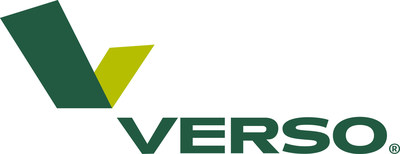
SOURCE Verso Corporation







